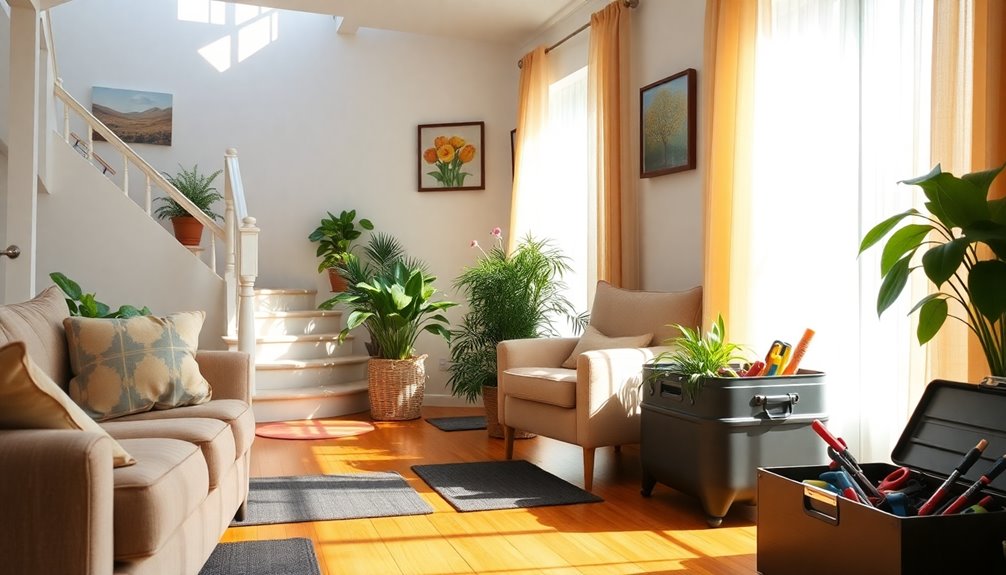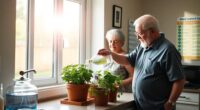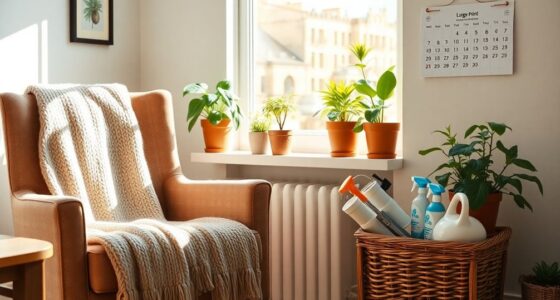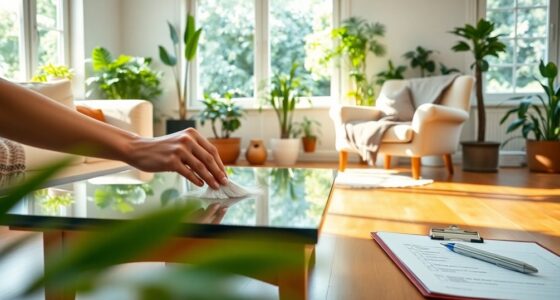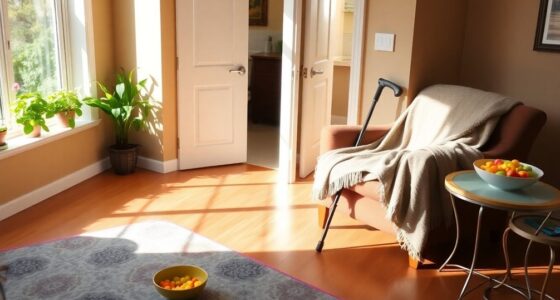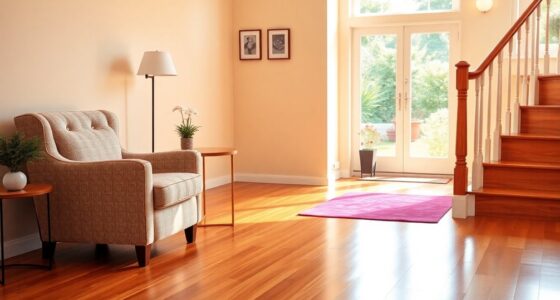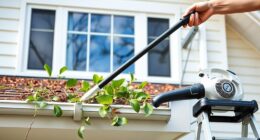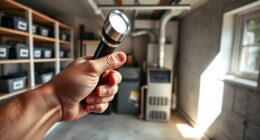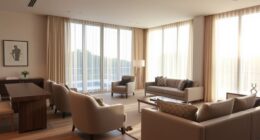To prolong the life of senior-friendly homes, start by conducting regular inspections for wear and tear, and keep pathways clear of clutter. Guarantee proper lighting throughout, and check batteries in safety devices regularly. Maintain plumbing to prevent leaks and test appliances for functionality. Monitor flooring for safety, and schedule routine home safety assessments. Finally, involve professionals for any specialized modifications needed. There's more to explore on making your home even safer and more comfortable!
Key Takeaways
- Conduct regular safety inspections to identify and address potential hazards before they escalate into serious issues.
- Maintain a clutter-free environment by removing unnecessary items to ensure safe and easy movement throughout the home.
- Install bright, glare-free lighting and use motion sensors to enhance visibility in key areas, reducing the risk of falls.
- Schedule routine plumbing and appliance maintenance to prevent leaks and ensure all systems are functioning efficiently.
- Consult with professionals for necessary modifications to promote accessibility and ensure long-term usability of the home for seniors.
Conduct Regular Inspections for Wear and Tear
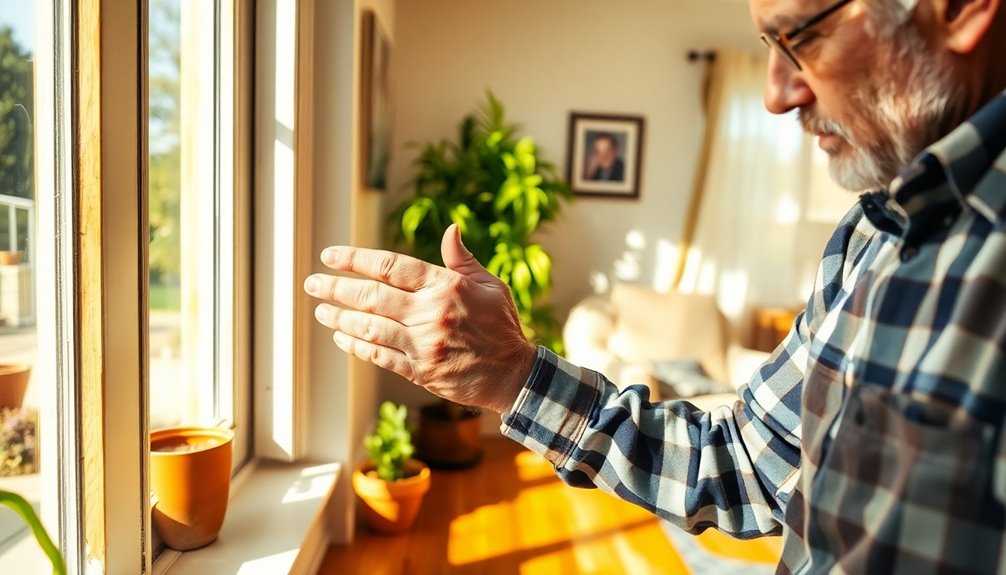
When you conduct regular inspections for wear and tear in a senior-friendly home, you can catch minor issues before they escalate into costly repairs.
Focus on high-traffic areas like hallways and entryways, ensuring safe and accessible pathways for seniors. Check for signs of water damage, especially in bathrooms and kitchens, where moisture can create health hazards.
Inspect flooring for loose tiles, warped boards, or frayed carpets to minimize fall risks that could jeopardize home safety.
Don't forget to conduct annual roof inspections to spot potential leaks or damage, averting severe structural issues down the line.
These proactive measures not only enhance safety but also support necessary home modifications, keeping your loved ones secure and comfortable.
Keep Pathways Clear of Clutter

Keeping pathways clear of clutter is vital for preventing falls in a senior-friendly home. Falls account for over 3 million emergency room visits among seniors each year, making it important to reduce fall risk.
Start by removing unnecessary furniture and decorations to create wider, unobstructed walking paths that enhance mobility, especially for those facing mobility challenges. Regularly assess rooms to verify items are easily accessible and don't impede movement.
Utilize storage solutions like bins and shelves to keep items off the floor, greatly lowering tripping hazards. Additionally, secure electrical cords and verify they're out of walking paths to minimize fall risks.
Ensure Proper Lighting Throughout the Home
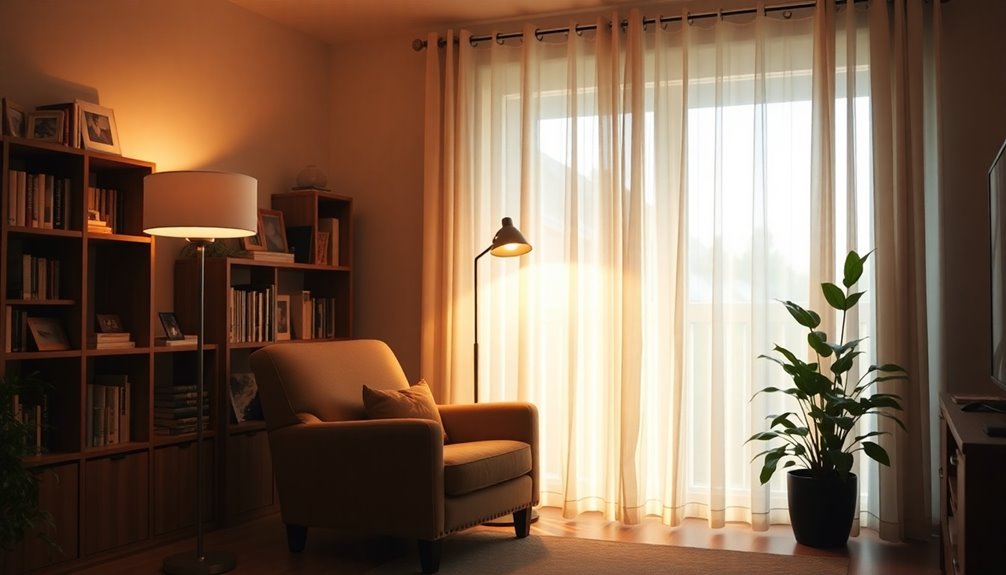
Good lighting is essential for creating a safe home environment for seniors.
You should consider installing bright, glare-free fixtures, along with motion-sensor lights that activate when you move through spaces.
Additionally, adding task lighting in areas like kitchens can help you perform daily activities without straining your eyes.
Bright, Glare-Free Lighting
Ensuring proper lighting throughout your home is essential for enhancing visibility and safety, especially for seniors who may have diminished eyesight. Bright, glare-free lighting fixtures help prevent accidents and falls, particularly in high-traffic areas. Here's a quick reference table for effective lighting modifications:
| Area | Lighting Type |
|---|---|
| Living Room | Soft, diffused lamps |
| Kitchen | Task lighting |
| Bathroom | Bright, glare-free |
| Hallways | Wall sconces |
| Entryways | Bright overhead lights |
Regularly check and replace burnt-out bulbs to maintain adequate lighting levels. By implementing these modifications, you can create a safer environment that empowers seniors to navigate their homes independently while minimizing the risk of falls. Additionally, consider using mineral-based sunscreens to protect skin during outdoor activities in bright lighting conditions. The right lighting can also enhance the quality of life for seniors, making their surroundings more inviting and comfortable. Moreover, maintaining proper air quality in the home can further improve comfort and health for seniors.
Motion-Sensor Light Installation
Installing motion-sensor lights can dramatically improve safety and visibility in your home. These devices automatically illuminate areas when someone approaches, making it easier for seniors to navigate without fear of falls.
By placing motion-sensor lights in entryways and hallways, you can considerably reduce the risk of accidents in low-visibility areas. Plus, they can be set to activate at dusk and turn off at dawn, ensuring consistent lighting throughout the night.
This feature is especially helpful for seniors who may have difficulty reaching light switches, promoting independence as they age in place. Adequate lighting not only enhances comfort but also serves as an essential safety device in maintaining a secure environment for everyone. Additionally, improving indoor air quality can further enhance overall safety and comfort for seniors, as air purifiers help reduce allergens and harmful pollutants in the home. Furthermore, HEPA filters in air purifiers capture up to 99.97% of airborne particles, contributing to a healthier living environment. Moreover, incorporating essential oils can also promote a calming atmosphere, enhancing the overall well-being of seniors at home.
Task Lighting Considerations
While motion-sensor lights greatly enhance safety in key areas of the home, effective task lighting is equally important for everyday activities.
You should strategically place task lighting in high-traffic areas and workspaces to guarantee adequate illumination, reducing the risk of accidents.
Consider incorporating adjustable lighting fixtures so you can customize brightness levels based on your needs, enhancing visibility during various tasks.
Using LED bulbs not only boosts energy efficiency but also provides brighter light, which is essential for aging eyes.
Additionally, high-contrast lighting, like different colors for surfaces and fixtures, can improve visibility and help you navigate your surroundings safely.
Together, these lighting strategies create a safer and more functional environment for seniors.
Check and Replace Batteries in Safety Devices

You should regularly test your smoke alarms and replace the batteries to keep your home safe.
Don't forget to check your carbon monoxide detectors too, as they play an essential role in preventing dangerous situations.
Staying on top of these maintenance tasks can greatly enhance your safety at home.
Test Smoke Alarms Regularly
How often do you check your smoke alarms? It's essential to test smoke alarms monthly to guarantee they're functioning properly.
Working smoke alarms can cut the risk of fire-related fatalities by 50%. Don't forget to replace batteries at least once a year or whenever you hear that chirping sound.
Additionally, smoke alarms should be replaced every 10 years, as sensors can deteriorate over time. For maximum safety coverage, install smoke alarms on every level of your home, including inside bedrooms and outside sleeping areas.
If possible, opt for interconnected smoke alarms, which alert all units when one alarm is triggered, enhancing early detection and response during emergencies. Regular maintenance also includes cleaning filters in air purifiers to ensure optimal performance and air quality, as HEPA filtration is critical for capturing small particles effectively. Regularly checking smoke alarms is as vital as piercing care and hygiene, which helps prevent infections. Stay safe by keeping your smoke alarms in top shape!
Replace Carbon Monoxide Detectors
Guaranteeing the safety of your home means regularly checking and replacing carbon monoxide detectors, especially since this odorless gas can pose serious risks.
Install detectors on every level, particularly near sleeping areas, for early detection. Test them monthly to confirm they're functioning properly and replace batteries at least once a year.
After 5 to 7 years, replace carbon monoxide detectors entirely, as their sensors may degrade over time. Many newer models offer enhanced safety awareness features like voice alerts and digital displays.
Regular maintenance of these devices not only reduces the risk of poisoning but also creates a safer home environment, particularly for seniors who are more vulnerable.
Prioritize this crucial aspect of senior living to guarantee peace of mind.
Maintain Plumbing to Prevent Leaks
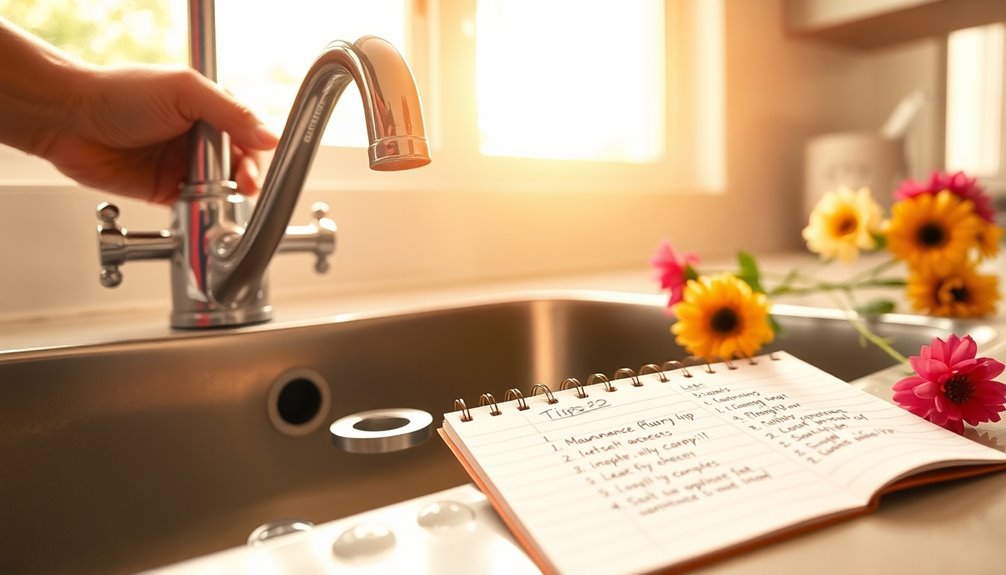
While it may seem minor, maintaining plumbing to prevent leaks is essential in senior-friendly homes. Regularly inspect plumbing fixtures like faucets and toilets for drips that waste water and cause damage. Check under sinks and around appliances for moisture, as early detection can save you from costly repairs. Make certain all hoses and connections are secure and free from corrosion, as these are common leak sources in older systems. Additionally, financial considerations for elderly care can help you budget for potential plumbing repairs. Consider installing water leak detection devices to alert you to any issues early on. Regular maintenance can also help mitigate the risk of most common automotive repairs that could lead to unexpected costs. Finally, schedule routine maintenance with a qualified plumber to keep pipes in good condition. Additionally, implementing a home security system can provide peace of mind by protecting against water damage or other emergencies.
| Task | Frequency | Purpose |
|---|---|---|
| Inspect plumbing fixtures | Monthly | Detect leaks early |
| Check hoses and connections | Quarterly | Prevent leaks from weakened joints |
| Schedule plumbing maintenance | Annually | Make certain overall system integrity |
Assess and Update Safety Features
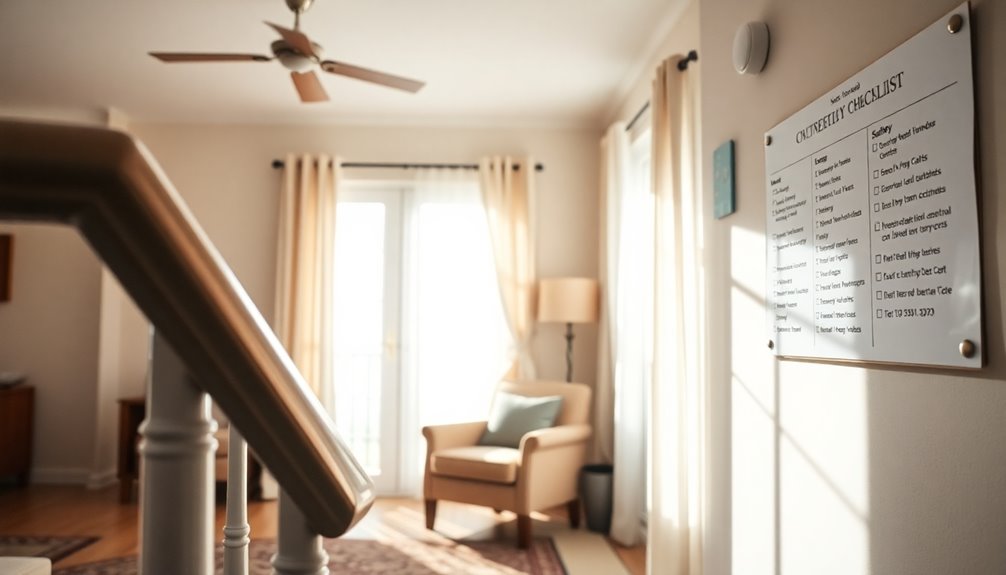
After addressing plumbing maintenance to prevent leaks, it's time to focus on evaluating and updating safety features in your home.
Start by checking smoke detectors and carbon monoxide alarms, ensuring they're installed on every level. This is vital for reducing fire-related injuries. Regularly changing HEPA filters in air purifiers can also help maintain a safer indoor environment. Additionally, ensuring that your broad-spectrum sunscreen is readily available can protect skin during outdoor activities.
Next, inspect grab bars in bathrooms; they should be securely placed to offer support during bathing and toileting.
Adequate lighting is essential, particularly in stairways and hallways, to prevent falls and enhance visibility.
Also, assess doorways for accessibility, confirming they're wide enough for mobility aids and free of tripping hazards.
Finally, conduct routine checks on handrails, ensuring they're securely anchored and extend beyond the top and bottom steps for added support. Incorporating natural materials in your home design can also enhance safety by creating a warm and inviting atmosphere.
Regularly Test and Maintain Appliances
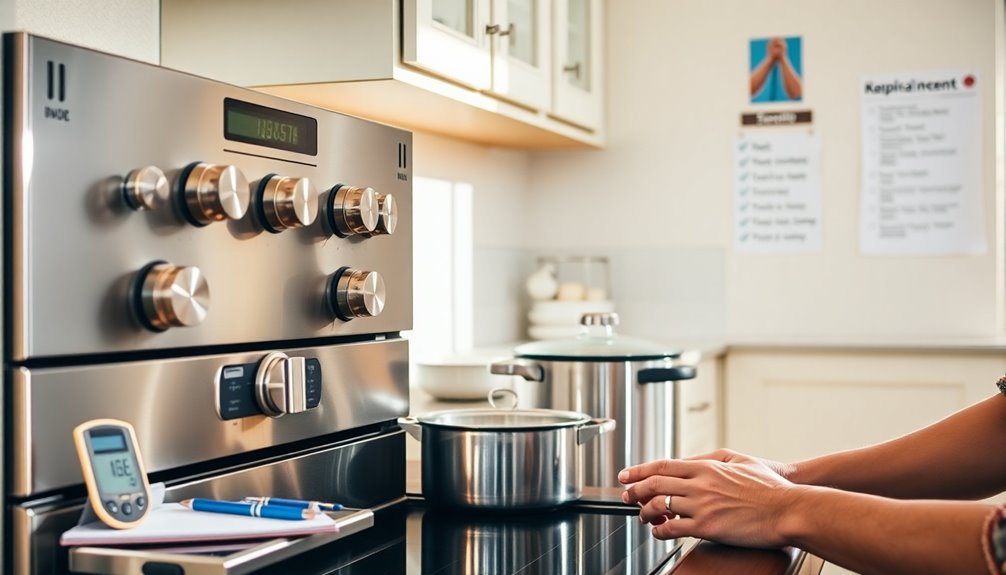
To keep your home safe and efficient, regularly testing and maintaining appliances is essential.
Make it a habit to:
- Regularly inspect appliances for wear or damage to guarantee safe operation.
- Clean refrigerator coils every six months to improve energy efficiency.
- Test smoke and carbon monoxide detectors monthly to maintain safety.
- Replace worn-out electrical cords immediately to prevent fire hazards.
Additionally, ensure your heating and cooling systems, like the best heat pump, are properly maintained to prevent costly breakdowns.
Monitor and Repair Flooring for Safety
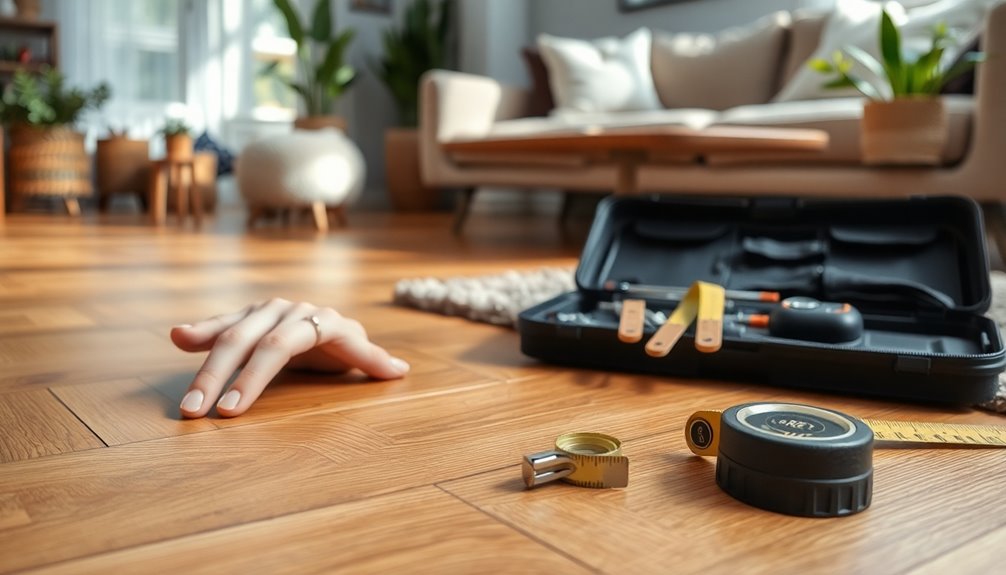
Keeping your home safe goes beyond just maintaining appliances; it also involves monitoring and repairing your flooring. Regularly inspect your flooring for cracks, warping, or loose tiles, as these can create significant tripping hazards, particularly for seniors.
Opt for slip-resistant flooring materials to help prevent falls, which are a leading cause of injuries in adults aged 65 and older. Keep your floors clean and free of clutter to guarantee clear pathways.
Consider using area rugs with non-slip backing or securing them with double-sided tape to prevent slipping. Finally, schedule annual professional assessments of flooring conditions in high-traffic areas to address any potential safety concerns promptly.
Prioritizing these steps will enhance the safety of your home for everyone.
Schedule Routine Home Safety Assessments

Scheduling routine home safety assessments is essential for identifying potential hazards that could lead to falls.
Involving your family in these assessments guarantees everyone is aware of necessary changes and improvements.
Plus, documenting your findings helps prioritize modifications and keeps everyone on the same page about maintaining a safe living environment.
Identify Potential Hazards Regularly
Regularly identifying potential hazards in your home is essential for guaranteeing a safe environment for seniors.
Conducting routine home safety assessments can greatly help in reducing falls, which are a leading cause of injury for aging parents.
Here are some critical areas to focus on during your assessments:
- Check for tripping hazards like loose rugs and clutter.
- Evaluate grab bars and handrails for proper placement and condition.
- Inspect lighting fixtures to guarantee adequate illumination.
- Document your findings to prioritize necessary modifications.
Involve Family in Assessments
When you involve family members in routine home safety assessments, you not only gain diverse perspectives but also deepen the understanding of the specific needs of your senior loved ones.
This collaboration helps identify potential safety concerns and necessary home modifications, ensuring a safer living environment. By working together, your family can monitor changes in mobility and address any new challenges that arise over time.
This shared responsibility fosters open communication about the unique needs of seniors, leading to tailored solutions.
Regular assessments with family participation also track the effectiveness of previous modifications and highlight areas needing improvement, contributing to the overall safety and accessibility of the home for your loved ones.
Document Changes and Improvements
To guarantee ongoing safety for seniors in their homes, it's essential to schedule routine safety assessments at least once a year.
These assessments help identify potential hazards specifically affecting aging residents. Make certain to document changes and improvements made during each assessment to track progress and enhance home safety effectively.
Involving family members can offer valuable insights into unique needs and preferences.
Here are key areas to assess:
- Lighting and visibility
- Tripping hazards, like rugs or cords
- Accessibility features, such as grab bars
- Emergency contact plans
Consider consulting certified aging-in-place specialists (CAPS) for expert recommendations on necessary modifications.
Involve Professionals for Specialized Modifications

Considering the unique challenges older adults face, involving professionals for specialized modifications is essential for creating a safe and accessible home environment.
Hiring Certified Aging in Place Specialists (CAPS) can greatly enhance your home improvements, as they're trained to address the specific needs of seniors. Their expertise affirms that modifications are effective, preventing costly design mistakes that could compromise safety.
Many older homes lack essential accessibility features, making professional input critical for achieving a senior-friendly space. The costs of modifications can vary, so consulting with CAPS helps you plan your budget wisely.
Whether it's adding grab bars or undertaking extensive renovations, involving professionals guarantees that your home will be tailored to support aging in place.
Frequently Asked Questions
How to Make a Home More Senior Friendly?
To make your home more senior-friendly, start by installing grab bars in bathrooms and using non-slip mats to minimize fall risks.
Upgrade door handles to lever-style for easier access and guarantee your entryways are well-lit with motion-sensor lights.
Create no-step entries and widen doorways to accommodate mobility aids like wheelchairs or walkers.
These adjustments enhance safety and accessibility, making daily activities easier and more comfortable for seniors living in your home.
What Are the 8 Needs of the Elderly?
You might think all seniors need the same things, but their needs can vary widely.
Generally, you'll find eight key areas: safety features to prevent falls, proper lighting for visibility, accessibility modifications for mobility, social interaction opportunities, nutritious meal access, health care support, emotional well-being resources, and transportation options.
Addressing these needs helps seniors maintain independence and enhances their quality of life, ensuring they feel secure and comfortable in their homes.
What Is the Most Requested Support Service for the Elderly?
The most requested support service for the elderly is in-home care.
You'll find that this service provides vital assistance with daily activities like bathing, dressing, and meal preparation, allowing seniors to maintain their independence.
Given that around 70% of seniors will eventually need long-term care, in-home support becomes essential.
Many prefer aging in place, finding it both comforting and more cost-effective than moving to assisted living facilities.
What Are Three Factors That May Improve the Quality of Life of the Elderly?
Improving the quality of life for the elderly is like planting a garden—nurturing it leads to beautiful blooms.
First, you can enhance safety with home modifications, like grab bars and better lighting, reducing fall risks.
Second, engaging community resources fosters social connections, combating loneliness.
Finally, implementing smart technology, like emergency alerts, provides peace of mind.
Together, these factors create a supportive environment, helping seniors thrive and enjoy their golden years.
Conclusion
In the words of Benjamin Franklin, "An ounce of prevention is worth a pound of cure." By following these ten maintenance tips, you can guarantee that your senior-friendly home remains safe, comfortable, and functional for years to come. Regular inspections, clear pathways, and proper lighting are just a few ways to enhance safety and livability. Remember, investing a little time and effort now can save you from bigger issues down the line. Keep your home a haven!
